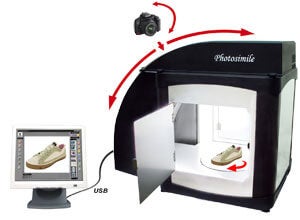
Whenever I buy things online I’ll click on the little images for the product and proceed to zoom and rotate until I’ve seen every angle of what I’m spending my money on. It’s about the closest I can come to playing with an object before purchasing it. Those still images and 3D animations typically require the (costly) work of a professional photographer. Well, no longer. Ortery has just started to sell its Photosimile 5000, a photo studio in a box retailing for $16,800 in the US. The Photosimile 5000 uses a SLR camera on a mount and specially calibrated lights to take 70+ photos of an object and generate a crisp 3D image. It looks sort of like someone took the special camera rigging from the Matrix movies and placed them in an over-sized printer. The Photosimile 5000 hooks up to a computer, allowing your average office worker to transform into the resident photography expert with just a few clicks. Check out the promo video after the break.
The Photosimile 5000 was first debuted at CES 2008, but had a long time getting to market. According to the Marketing rep I talked with, Ortery first thought about using a Canon Powershot in the enclosure but industry feedback eventually guided them to use a SLR instead (the Canon EOS). That lead to some redesigns in hardware and software…long story short, they wanted to get the Photosimile done right and that took the better part of two years. The rep was also able to clear up some issues about pricing that many have wondered about: MSRP is $16,800. Due to exclusive distribution agreements around the world, however, most customers outside the US will pay (significantly) more.
Now, the Photosimile interests me for two reasons. First, it effectively replaces human photographers for many small product shoots. If you have a friend trying to make their living behind the lens you may have heard them complain about this kind of work. It’s tedious and there’s little artistic license allowed…but it’s also a steady gig. The 5000 isn’t big enough to handle all such product photo work – the case is around 28x28x28 inches, and the effective size for objects is about 6 inches less in each direction. Still, you’ve got to think that when someone with no photographic training can just place an object in a box and push ‘go’ the allure of paying a photographer $100+/hr to do the same thing by hand is going to fade. The automation of jobs is starting to crop up in some unlikely places. Is it strange that journalists and photographers may be some of the first on the chopping block?
The other thing that interests me about the Photosimile 5000 is that it exists along side 3D scanners, but doesn’t seem to compete with them. Next Engine has a high quality automated 3D scanner that pivots objects on a mount to generate a digital image and design. You can plug it into a 3D printer and essentially create a 3D photocopier. Retail price for the Next Engine scanner: less than $3000. Heck, even the top of the line Z Corp scanners are $29,000 and they come with more bells and whistles than a court jester on a train.
Yet the Photosimile 5000 is simply in a different market. Customers are going to care about the high quality natural lighting (6500K) more than being able to create a CAD file. No, the Photosimile won’t help you print a 3D plastic model, but it does allow you to plan pans and zooms for an animation and then repeat them for a million different products in a catalog. Ortery has some cool examples of these animations – they look pretty much like the product examples you see when buying things online.
Internet sales are going to outstrip traditional retail purchases, and that makes product presentation a growing and important sector for small businesses. With the Photosimile 5000 the sector may be dominated by robots rather than humans. Bad news for the unemployed photographer out there. I’m interested to see how automation may grab other “jobs” generated by growing online business. Will automated web design take off? Maybe some slick software can improve your SEO. Thankfully, I’m sure that bloggers could never be automated.
never be automated.
never be automated.
never be automated.
never be auto—-
FATAL SYSTEM ERROR
[photo and video credit: Ortery]


